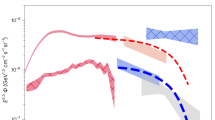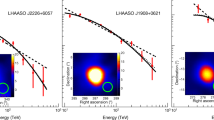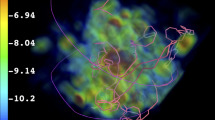Abstract
THE existence of a finite flux of diffuse cosmic photons in the energy region of about 1 keV to about 1 MeV is well established1–9. Furthermore, from observations on the isotropy of the radiation in the energy region of 1–100 keV, it is generally believed that a dominant fraction of the radiation in this energy band, if not all of it, is of extragalactic origin10–11. On the other hand, at energies above ∼200 keV, there is, as yet, no observational evidence for the isotropy or otherwise of the diffuse radiation, although some authors have advanced indirect arguments in favour of their extragalactic nature12. More recently there have been attempts to interpret the diffuse cosmic gamma rays in the neighbourhood of 1 MeV as of galactic origin13. From a study of the directionality of the diffuse cosmic gamma rays between about 200 keV and 4 MeV, we present in this communication the first observational evidence of their extragalactic nature.
This is a preview of subscription content, access via your institution
Access options
Subscribe to this journal
Receive 51 print issues and online access
$199.00 per year
only $3.90 per issue
Buy this article
- Purchase on SpringerLink
- Instant access to full article PDF
Prices may be subject to local taxes which are calculated during checkout
Similar content being viewed by others
References
Baxter, A. J., Wilson, B. G., and Green, D. W., Canad. J. Phys., 47, 2651 (1969).
Bleeker, J. A. M., and Deerenberg, A. J. M., Astrophys. J., 159, 215 (1970).
Damle, S. V., Daniel, R. R., Joseph, G., and Lavakare, P. J., Proc. Twelfth Intern. Conf. Cosmic Rays, 1, 84 (Hobart, 1971).
Damle, S. V., Daniel, R. A., Joseph, G., and Lavakare, P. J., Astrophys. Space Sci. (in the press).
Gorenstein, P., Kellogg, E. M., and Gursky, H., Astrophys. J., 156, 315 (1969).
Hayakawa, S., Kato, T., Makino, F., Ogawa, H., Tanaka, Y., Yamashito, K., Matsuoka, M., Oda, M., Ogawara, Y., and Miyamoto, S., Proc. Intern. Astron. Union Symp. (edit. by Gratton, L.), 37 (Reidel, Dordrecht, 1970).
Metzger, A. E., Anderson, E. C., Van Dilla, M. A., and Arnold, J. R., Nature, 204, 766 (1964).
Schwartz, D. A., thesis, Univ. California, San Diego (1969).
Bette, J. I., Gruber, D., Matteson, J. L., and Peterson, L. E., Astrophys. J. Lett., 160, L161 (1970).
Gould, R. J., and Burbidge, G. R., Astrophys. J., 138, 969 (1963).
Felten, J. E., and Morrison, P., Astrophys. J., 146, 686 (1966).
Stecker, F. W., Vette, J. I., and Trombka, J. I., Nature Physical Science, 231, 122 (1971).
Cowsik, R., Proc. International Conference on Cosmic Rays, 1, 334 (Hobart, 1971).
Shivanandan, K., Houck, J. R., and Harwit, M., Phys. Rev. Lett., 21, 1460 (1968).
Houck, J. R., and Harwit, M., Astrophys. J. Lett., 157, L45 (1969).
Author information
Authors and Affiliations
Rights and permissions
About this article
Cite this article
DAMLE, S., DANIEL, R., JOSEPH, G. et al. Extragalactic Origin of Low Energy Gamma Rays. Nature 235, 319–320 (1972). https://doi.org/10.1038/235319a0
Received:
Revised:
Issue date:
DOI: https://doi.org/10.1038/235319a0
This article is cited by
-
The X and γ diffuse background
La Rivista del Nuovo Cimento (1975)
-
Diffuse Cosmic Gamma rays: Present Status of Theory and Observations
Nature Physical Science (1973)
-
Diffuse cosmic gamma rays observed at an equatorial balloon altitude
Astrophysics and Space Science (1972)



